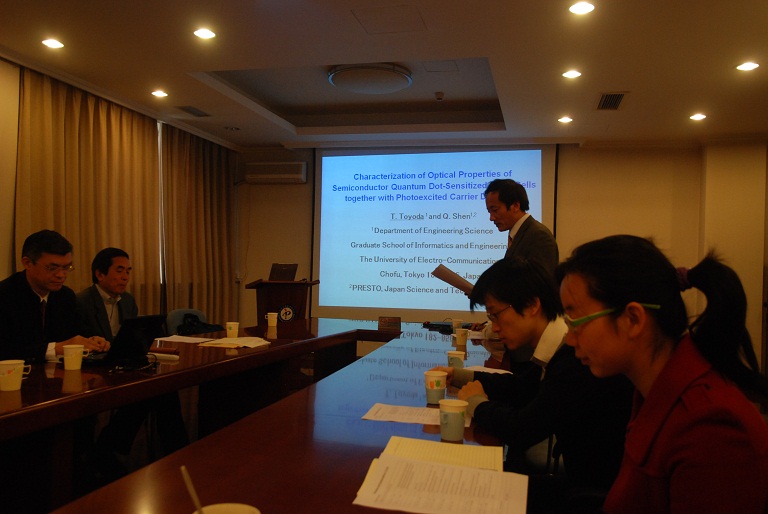光化学委员会光电化学系列讲座(三十、三十一) 2011-3-18
中国可再生能源学会、光化学委员会光电化学系列讲座(三十、三十一)

时间:2011年3月18日(星期五) 上午 9:30—11:30
1、报告题目:Characterization of Optical Properties of Semiconductor Quantum Dot-Sensitized Solar Cells Together with Ultrafast Carrier Dynamics
报告人:Prof. Taro Toyoda
Department of Engineering Science, Faculty of Informatics and Engineering, The University of Electro-Communications, Japan
报告摘要:
In this talk, Prof. Toyoda will introduce their work on CdSe QD-sensitized solar cells based on different kinds of nanostructured TiO2 electrodes with nanoparticles, nanotubes and inverse opal structure (photonic crystal). Sandwich structure solar cells were prepared by using the Cu2S counter electrode and polysulfide electrolyte. Optical absorption characterization was carried out with photoacoustic (PA) spectroscopy. Photoexcited carrier dynamics is characterized with the improved transient grating (TG) technique, which depends on the refractive index change by photoexcited carrier population. TG measurements show the fast (hole) and slow (electron) relaxation processes with lifetimes of a few picoseconds and a few tens to hundred picoseconds, respectively. Correlations between the lifetimes of photoexcited carrier dynamics and the photovoltaic properties will be discussed.
报告人简历:
Prof. Taro Toyoda is a professor of Engineering Science at the University of Electro-Communications since 1989. He received his B.S., M.Sc, and D.Sc. degrees from the Tokyo Metropolitan University. After getting D.Sc. degree, he worked at National Research Council of Canada, Fuji Electric Co. Ltd., Japan Mining Co. Ltd, and Tokyo Kogakuin College of Technology. His current major research interests include optical properties of semiconductor, metal quantum dots and their applications to photovoltaic devices.
2、报告题目:Multiple Electron Injection from Dye Molecules to Metal Oxide Semiconductor for Dye-Sensitized Solar Cells
报告人:Prof. Shuzi Hayase
Graduate School of Life Science and Systems Engineering at Kyushu Institute of Technology, Japan
报告摘要:
In this talk, Prof. Hayase will report a hybrid dye system in which two dyes are linked linearly by a metal-O-metal linkage for dye sensitized solar cells (cell-NcSn-N719). Tin(IV)2,11,20,29-tetra-tert-butyl-2,3-naphthalocyanine (NcSn) was adsorbed on SnO2 surface by a Sn(p)-O-Sn(n) linkage, where Sn(p) and Sn(n) stand for a Sn atom on Sn nanoparticle surface and that in the center of NcSn, respectively. N719 was bonded to the NcSn by a –Sn(n)-O-CO-linkage. The incident photon to photocurrent efficiency (IPCE) curve of cell-NcSn-N719 suggested that electrons are injected from both of N719 and NcSn to SnO2 nanoparticles.
报告人简介:
Prof. Shuzi Hayase is a professor of Graduate School of Life Science and Systems Engineering at Kyushu Institute of Technology. He is also the research supervisor of the PRESTO project“Photoenergy conversion systems and materials for the next generation solar cells” of Japan Science and Technology Agency (JST). Prof. Hayase received his B.S., M.S. and Ph.D. degrees from Osaka University. After getting his Ph.D. degree in 1978, he joined Toshiba Research and Development Center engaging on latent catalysts for insulators, LSI lithography and opto and Electronic polymers. From 1988 to 1990, he joined the polysilane Research group in Wisconsin University (Robert West) as a research scientist studying on p-type conductive polymers. Then he returned to Toshiba Research and Development Center studying on application of polysilanes to LSI, materials for solar cells and fuel cells. His current major research interests include solar cells, organic FET, fuel cells and emission devices. He received awards for Technological Development by The Japan Electrical Manufacturers’ Association in 1996, for distinguished contributions in technological development in chemical industry in 1992, and National Commendation for Invention by Japan Institute of Invention and Innovation in 1987.
